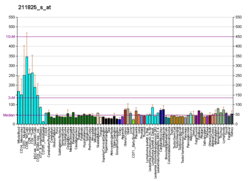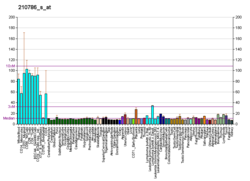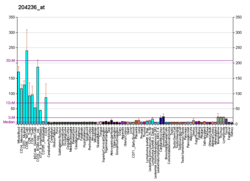FLI1
Friend leukemia integration 1 transcription factor(FLI1), also known astranscription factor ERGB,is aproteinthat in humans is encoded by theFLI1gene,which is aproto-oncogene.[5][6][7]
Function[edit]
Fli-1 is a member of theETS transcription factor familythat was first identified inerythroleukemiasinduced by Friend Murine Leukemia Virus (F-MuLV). Fli-1 is activated throughretroviralinsertional mutagenesisin 90% of F-MuLV-induced erythroleukemias. The constitutive activation of fli-1 inerythroblastsleads to a dramatic shift in theEpo/Epo-Rsignal transduction pathway, blocking erythroid differentiation, activating theRaspathway, and resulting in massive Epo-independent proliferation of erythroblasts. These results suggest that Fli-1 overexpression in erythroblasts alters their responsiveness to Epo and triggers abnormal proliferation by switching the signaling event(s) associated with terminal differentiation to proliferation.[citation needed]
Clinical significance[edit]
In addition to Friend erythroleukemia, proviral integration at the fli-1 locus also occurs in leukemias induced by the 10A1, Graffi, and Cas-Br-E viruses. Fli-1 aberrant expression is also associated with chromosomal abnormalities in humans. In pediatricEwing’s sarcomaa chromosomal translocation generates a fusion of the 5’ transactivation domain ofEWSR1(also known as EWS) with the 3’ Ets domain of Fli-1. The resulting fusion oncoprotein, EWS/Fli-1, acts as an aberrant transcriptional activator.[8]with strong transforming capabilities. EWS/Fli-1 may steer clinically important genes via interaction withenhancer-like GGAA-microsatellites.[9]The importance of Fli-1 in the development of human leukemia, such as acute myelogenous leukemia (AML), has been demonstrated in studies of translocation involving theTeltranscription factor, which interacts with Fli-1 through protein-protein interactions. A recent study has demonstrated high levels of Fli-1 expression in several benign and malignant neoplasms using immunohistochemistry.[citation needed]
A possible association withParis-Trousseau syndromehas been suggested.[10]
References[edit]
- ^abcGRCh38: Ensembl release 89: ENSG00000151702–Ensembl,May 2017
- ^abcGRCm38: Ensembl release 89: ENSMUSG00000016087–Ensembl,May 2017
- ^"Human PubMed Reference:".National Center for Biotechnology Information, U.S. National Library of Medicine.
- ^"Mouse PubMed Reference:".National Center for Biotechnology Information, U.S. National Library of Medicine.
- ^Baud V, Lipinski M, Rassart E, Poliquin L, Bergeron D (September 1991). "The human homolog of the mouse common viral integration region, FLI1, maps to 11q23-q24".Genomics.11(1): 223–4.doi:10.1016/0888-7543(91)90124-W.PMID1765382.
- ^Prasad DD, Rao VN, Reddy ES (October 1992). "Structure and expression of human Fli-1 gene".Cancer Research.52(20): 5833–7.PMID1394211.
- ^Rao VN, Ohno T, Prasad DD, Bhattacharya G, Reddy ES (August 1993). "Analysis of the DNA-binding and transcriptional activation functions of human Fli-1 protein".Oncogene.8(8): 2167–73.PMID8336942.
- ^Ohno T, Rao VN, Reddy ES (December 1993). "EWS/Fli-1 chimeric protein is a transcriptional activator".Cancer Research.53(24): 5859–63.PMID7503813.
- ^Musa J, Cidre-Aranaz F, Aynaud MM, Orth M, Mirabeau O, Varon M, Grossetete S, Surdez D, et al. (2018-12-27)."Cooperation of dominant oncogenes with regulatory germline variants shapes clinical outcomes in childhood cancer".bioRxiv:506659.doi:10.1101/506659.
- ^Raslova H, Komura E, Le Couédic JP, Larbret F, Debili N, Feunteun J, et al. (July 2004)."FLI1 monoallelic expression combined with its hemizygous loss underlies Paris-Trousseau/Jacobsen thrombopenia".The Journal of Clinical Investigation.114(1): 77–84.doi:10.1172/JCI21197.PMC437972.PMID15232614.
Further reading[edit]
- Ben-David Y, Giddens EB, Bernstein A (February 1990)."Identification and mapping of a common proviral integration site Fli-1 in erythroleukemia cells induced by Friend murine leukemia virus".Proceedings of the National Academy of Sciences of the United States of America.87(4): 1332–6.Bibcode:1990PNAS...87.1332B.doi:10.1073/pnas.87.4.1332.PMC53469.PMID2304901.
- Ben-David Y, Giddens EB, Letwin K, Bernstein A (June 1991)."Erythroleukemia induction by Friend murine leukemia virus: insertional activation of a new member of the ets gene family, Fli-1, closely linked to c-ets-1".Genes & Development.5(6): 908–18.doi:10.1101/gad.5.6.908.PMID2044959.
- Delattre O, Zucman J, Plougastel B, Desmaze C, Melot T, Peter M, et al. (September 1992). "Gene fusion with an ETS DNA-binding domain caused by chromosome translocation in human tumours".Nature.359(6391): 162–5.Bibcode:1992Natur.359..162D.doi:10.1038/359162a0.PMID1522903.S2CID4331584.
- Pereira R, Quang CT, Lesault I, Dolznig H, Beug H, Ghysdael J (February 1999). "FLI-1 inhibits differentiation and induces proliferation of primary erythroblasts".Oncogene.18(8): 1597–608.doi:10.1038/sj.onc.1202534.PMID10102630.S2CID25190024.
- Tamir A, Howard J, Higgins RR, Li YJ, Berger L, Zacksenhaus E, et al. (June 1999)."Fli-1, an Ets-related transcription factor, regulates erythropoietin-induced erythroid proliferation and differentiation: evidence for direct transcriptional repression of the Rb gene during differentiation".Molecular and Cellular Biology.19(6): 4452–64.doi:10.1128/mcb.19.6.4452.PMC104404.PMID10330185.
- Zochodne B, Truong AH, Stetler K, Higgins RR, Howard J, Dumont D, et al. (May 2000). "Epo regulates erythroid proliferation and differentiation through distinct signaling pathways: implication for erythropoiesis and Friend virus-induced erythroleukemia".Oncogene.19(19): 2296–304.doi:10.1038/sj.onc.1203590.PMID10822380.S2CID7468572.
- Starck J, Doubeikovski A, Sarrazin S, Gonnet C, Rao G, Skoultchi A, et al. (January 1999)."Spi-1/PU.1 is a positive regulator of the Fli-1 gene involved in inhibition of erythroid differentiation in friend erythroleukemic cell lines".Molecular and Cellular Biology.19(1): 121–35.doi:10.1128/mcb.19.1.121.PMC83871.PMID9858537.
- Truong AH, Ben-David Y (December 2000). "The role of Fli-1 in normal cell function and malignant transformation".Oncogene.19(55): 6482–9.doi:10.1038/sj.onc.1204042.PMID11175364.S2CID28146474.
- Ohno T, Rao VN, Reddy ES (December 1993). "EWS/Fli-1 chimeric protein is a transcriptional activator".Cancer Research.53(24): 5859–63.PMID7503813.
- Dhulipala PD, Lee L, Rao VN, Reddy ES (September 1998)."Fli-1b is generated by usage of differential splicing and alternative promoter".Oncogene.17(9): 1149–57.doi:10.1038/sj.onc.1202030.PMID9764825.
- Rao VN, Ohno T, Prasad DD, Bhattacharya G, Reddy ES (August 1993). "Analysis of the DNA-binding and transcriptional activation functions of human Fli-1 protein".Oncogene.8(8): 2167–73.PMID8336942.
- Ban J, Siligan C, Kreppel M, Aryee D, Kovar H (2006). "Ews-Fli1 in Ewing's Sarcoma: Real Targets and Collateral Damage".New trends in cancer for the 21st century.Advances in Experimental Medicine and Biology. Vol. 587. pp. 41–52.doi:10.1007/978-1-4020-5133-3_4.ISBN978-1-4020-4966-8.PMID17163154.
- Prasad DD, Rao VN, Reddy ES (October 1992). "Structure and expression of human Fli-1 gene".Cancer Research.52(20): 5833–7.PMID1394211.
- Watson DK, Smyth FE, Thompson DM, Cheng JQ, Testa JR, Papas TS, Seth A (October 1992). "The ERGB/Fli-1 gene: isolation and characterization of a new member of the family of human ETS transcription factors".Cell Growth & Differentiation.3(10): 705–13.PMID1445800.
- Delattre O, Zucman J, Plougastel B, Desmaze C, Melot T, Peter M, et al. (September 1992). "Gene fusion with an ETS DNA-binding domain caused by chromosome translocation in human tumours".Nature.359(6391): 162–5.Bibcode:1992Natur.359..162D.doi:10.1038/359162a0.PMID1522903.S2CID4331584.
- Baud V, Lipinski M, Rassart E, Poliquin L, Bergeron D (September 1991). "The human homolog of the mouse common viral integration region, FLI1, maps to 11q23-q24".Genomics.11(1): 223–4.doi:10.1016/0888-7543(91)90124-W.PMID1765382.
- Bergeron D, Poliquin L, Kozak CA, Rassart E (January 1991)."Identification of a common viral integration region in Cas-Br-E murine leukemia virus-induced non-T-, non-B-cell lymphomas".Journal of Virology.65(1): 7–15.doi:10.1128/JVI.65.1.7-15.1991.PMC240483.PMID1845910.
- Bhagirath T, Abe S, Nojima T, Yoshida MC (June 1995). "Molecular analysis of a t(11;22) translocation junction in a case of Ewing's sarcoma".Genes, Chromosomes & Cancer.13(2): 126–32.doi:10.1002/gcc.2870130209.PMID7542907.S2CID36929552.
- Liang H, Mao X, Olejniczak ET, Nettesheim DG, Yu L, Meadows RP, et al. (December 1994). "Solution structure of the ets domain of Fli-1 when bound to DNA".Nature Structural Biology.1(12): 871–5.doi:10.1038/nsb1294-871.PMID7773776.S2CID26261743.
- May WA, Lessnick SL, Braun BS, Klemsz M, Lewis BC, Lunsford LB, et al. (December 1993)."The Ewing's sarcoma EWS/FLI-1 fusion gene encodes a more potent transcriptional activator and is a more powerful transforming gene than FLI-1".Molecular and Cellular Biology.13(12): 7393–8.doi:10.1128/mcb.13.12.7393.PMC364810.PMID8246959.
- Hromas R, May W, Denny C, Raskind W, Moore J, Maki RA, et al. (February 1993). "Human FLI-1 localizes to chromosome 11Q24 and has an aberrant transcript in neuroepithelioma".Biochimica et Biophysica Acta (BBA) - Gene Structure and Expression.1172(1–2): 155–8.doi:10.1016/0167-4781(93)90283-J.PMID8439553.
- Magnaghi-Jaulin L, Masutani H, Robin P, Lipinski M, Harel-Bellan A (March 1996)."SRE elements are binding sites for the fusion protein EWS-FLI-1".Nucleic Acids Research.24(6): 1052–8.doi:10.1093/nar/24.6.1052.PMC145748.PMID8604338.
- Barbeau B, Bergeron D, Beaulieu M, Nadjem Z, Rassart E (June 1996). "Characterization of the human and mouse Fli-1 promoter regions".Biochimica et Biophysica Acta (BBA) - Gene Structure and Expression.1307(2): 220–32.doi:10.1016/0167-4781(96)00060-7.PMID8679708.
- Watson DK, Robinson L, Hodge DR, Kola I, Papas TS, Seth A (January 1997)."FLI1 and EWS-FLI1 function as ternary complex factors and ELK1 and SAP1a function as ternary and quaternary complex factors on the Egr1 promoter serum response elements".Oncogene.14(2): 213–21.doi:10.1038/sj.onc.1200839.PMID9010223.
- Kwiatkowski BA, Bastian LS, Bauer TR, Tsai S, Zielinska-Kwiatkowska AG, Hickstein DD (July 1998)."The ets family member Tel binds to the Fli-1 oncoprotein and inhibits its transcriptional activity".The Journal of Biological Chemistry.273(28): 17525–30.doi:10.1074/jbc.273.28.17525.PMID9651344.
- Carrère S, Verger A, Flourens A, Stehelin D, Duterque-Coquillaud M (June 1998). "Erg proteins, transcription factors of the Ets family, form homo, heterodimers and ternary complexes via two distinct domains".Oncogene.16(25): 3261–8.doi:10.1038/sj.onc.1201868.PMID9681824.S2CID26807714.
- Zucman-Rossi J, Legoix P, Victor JM, Lopez B, Thomas G (September 1998)."Chromosome translocation based on illegitimate recombination in human tumors".Proceedings of the National Academy of Sciences of the United States of America.95(20): 11786–91.Bibcode:1998PNAS...9511786Z.doi:10.1073/pnas.95.20.11786.PMC21718.PMID9751743.
- Dalgleish P, Sharrocks AD (January 2000)."The mechanism of complex formation between Fli-1 and SRF transcription factors".Nucleic Acids Research.28(2): 560–9.doi:10.1093/nar/28.2.560.PMC102515.PMID10606656.
- Knoop LL, Baker SJ (August 2000)."The splicing factor U1C represses EWS/FLI-mediated transactivation".The Journal of Biological Chemistry.275(32): 24865–71.doi:10.1074/jbc.M001661200.PMID10827180.
- Spyropoulos DD, Pharr PN, Lavenburg KR, Jackers P, Papas TS, Ogawa M, Watson DK (August 2000)."Hemorrhage, impaired hematopoiesis, and lethality in mouse embryos carrying a targeted disruption of the Fli1 transcription factor".Molecular and Cellular Biology.20(15): 5643–52.doi:10.1128/MCB.20.15.5643-5652.2000.PMC86032.PMID10891501.
- Mastrangelo T, Modena P, Tornielli S, Bullrich F, Testi MA, Mezzelani A, et al. (August 2000). "A novel zinc finger gene is fused to EWS in small round cell tumor".Oncogene.19(33): 3799–804.doi:10.1038/sj.onc.1203762.PMID10949935.S2CID24580332.
External links[edit]
- FLI1+protein,+humanat the U.S. National Library of MedicineMedical Subject Headings(MeSH)
This article incorporates text from theUnited States National Library of Medicine,which is in thepublic domain.










